by Winding Pathways | Apr 20, 2023 | (Sub)Urban Homesteading, Garden/Yard, Garden/Yard
People make a “to-do” about moles. They might be the most disliked animal in suburbia. We have them at Winding Pathways and are sharing tips on what we do about them.
Human Created Problems
Suburban and urban soil has a common problem. It is too often compacted. Construction companies often scrape topsoil off a yard before building a house. Then, they drive vehicles in the yard. When a family moves in, they soon create a dog run, drive their cars on the grass, and play on the lawn. Too many footsteps by pooches or people compact the ground.
Nature Has Solutions
Lawn plants struggle to thrive in tight soil, but nature has a remedy. Fossorial animals live in the soil and include moles, gophers, shrews, ants, worms, and others. Their burrowing constantly mixes and softens the dirt they live in, making it easier for plants to live.
Moles or Gophers?
People often confuse moles with gophers, but it’s easy to tell them apart. Moles prefer living in moist shady places and are at home in suburbia. They eat grubs and worms. Gophers, in contrast, are more likely to live in rural sunny pastures with dry soil and mostly eat roots. Mole hills are symmetrical, like mini volcano cones. Gophers, in contrast, make elliptical hills.
What Do You Really Value?
Ironically, most people who trap or poison moles profess to love a rich, green, “healthy” lawn, ignoring that nature loves diversity, not monocultures. Moles help make healthy lawns happen. Granted their hills of dirt and heaped linear tunnels can be unsightly and catch lawn mower blades.
Here is what we do at Winding Pathways:
- Thank our moles for helping make the soil soft and fertile.
- Rake out their hills before mowing.
- Stomp down their raised tunnels so our lawn mower does not catch on them.
- Enjoy the diversity of life in our yard.
Moles are as fascinating and beneficial as the butterflies that pollinate blooms or the cardinals who pluck seeds from feeders. They deserve respect for their valuable work.
-

-
Moles bring rich dirt from below to the surface as they tunnel along hunting for earthworms and grubs.
-
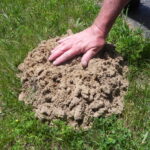
-
Moles sometimes push up excess dirt.
-
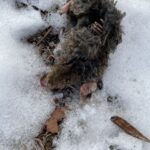
-
Moles’ feet are made for clearing dirt away.
by Winding Pathways | Mar 30, 2023 | (Sub)Urban Homesteading, Travel/Columns
We Bring Along Backpacker Meals*
We don’t do wilderness backpacking anymore but we are never far from backpacker meals at home and when we travel.
Last May we drove to Casper, Wyoming, with plans to set our tent up at Nebraska’s Smith Falls State Park the first night and the Forest Service’s Toadstool Campground the next. Normally, we’re camping softies. After setting our tent up we choose to go to a nearby town and enjoy a restaurant meal. That didn’t work in Nebraska.

Try some tasty meals.
After arriving at Smith Falls Park, we set up camp and walked to the surprisingly tall waterfall. Gorgeous! Worth a visit. Then, it was dinner time and we were hungry. But no town or restaurant was within miles and we’d already spent too much time in the car that day. So, we pulled our GoodTo-Go backpacker meal bin out of the car.
Our small bin contains these things:
- A few backpacker dehydrated meals that keep well. We also use Right On Trek.
- A tiny backpacker stove and fuel bottle – and matches!
- A bottle of water and a small pot.
- Utensils and bowls.
Within minutes we had our Pocket Rocket stove beneath a pot of boiling water. Soon our dehydrated meal was ready to eat. It hit the spot, cleanup was easy, and we had enough time before darkness for a birding walk.
-
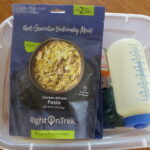
-
A small bin holds all we need.
-

-
Items on display
Dehydrated Meals
Many types of dehydrated meals came on the market decades ago. They were OK and fine for hungry, backwoods backpackers but hardly delicious. That’s changed. Today several companies make meals that are easy to prepare with simple camp equipment and are nutritious and quite delicious. Although marketed for backpackers they are perfect for keeping in the car in case there’s no cafe nearby. They’re also outstanding to keep in a basement emergency bin in case a storm knocks out power.
Camp Stoves

Note the size difference in equipment
Like dehydrated meals, camp stoves have evolved from heavy cumbersome pump-up models of years ago to lightweight compact, and effective backpacking stoves. Ours is called a Pocked Rocket made by MSR. It takes up only a tiny space in our bin and boils water quickly. A fuel bottle lasts for several meals. No pumping is required. Remember matches if the stove lacks an igniter.
Other Things
During COVID-19 we ended up with many disposable knife/fork/spoon sets wrapped in paper napkins packed along with carryout meals. We put unused utensil kits in our meal bin along with a couple of bowls.
When we travel, even to visit friends or relatives knowing we will stay with them, we always stow our backpacker meal bin in the car. Usually, we don’t need it. We eat with friends or a cafe is close to the campground. However, like what happened at Smith Falls, having simple-to-cook meals and a micro stove makes the difference between enjoying a pleasant meal or going to bed hungry.
* Winding Pathways remarks are our own. We make non-paid, independent evaluations unless otherwise noted.
by Marion Patterson | Mar 23, 2023 | (Sub)Urban Homesteading, Energy Efficiency, Home Improvements
Are battery-powered chainsaws worth the money?
We decided to find out. *
Gas chainsaws have been around for decades. Rich wondered if newer electric battery-powered chainsaws would be as functional and easier to use. So, he acquired a Milwaukee saw with a 16-inch bar and put it to the test alongside his trusty Stihl gas model.
Back in the mid-1970s Rich worked in Idaho felling Douglas Fir and Ponderosa Pine trees. He used a heavy noisy gas fueled chainsaw that was amazingly powerful as it chewed through thick trunks. Years later he bought a Stihl gas-powered saw used to cut the four or five cords of wood we burn each winter for heat. It’s a well-built powerful saw.
A few days after the new battery saw arrived, we heard a crack/boom as a huge oak crashed down across one of our backyard trails. Rich guided the new saw as it sliced through the log, and emerged smiling. “It’s amazing,” he said.
After further use he developed this chart of the pros and cons of the battery vs the gas saw:
Gas: Pro – Plenty of Power, No need to recharge batteries, Longer bar
Gas: Con Noisy and heavy, Must mix/carry/store gas, Must replace gas & air filters, Engine stalls, Pull cord start hard on the shoulder.
Battery: Pro – Plenty of Power, Relatively quiet, Less maintenance, Fairly lightweight, Trigger start, No need to idle, Easy start
Battery: Con – Need a nearby electric outlet to recharge the battery, Shorter bar than a gas saw
Bottom Line. Which One to Buy
Rich has both a gas and electric battery saw. Both are well-made by reliable companies. So, if he didn’t own a saw and needed to cut up trees fallen in the yard which type would he buy?
“I’d buy a quality battery saw. They are easy to use, cut fast, and there’s no need to buy, mix, and store gas. They are also quiet, but I still use hearing protection when using one. There are major advantages of battery over gas. One is
eliminating the need to pull a cord to start it. You just pull the trigger. The second is especially helpful when cutting a fallen tree with branches. Often this requires cutting, then putting the saw aside to clear away the cut branches, then using the saw to cut more. Gas saws don’t idle well and often stall, requiring another pull on the starter cord. Also, when idling gas saws burn fuel and spew emissions. Battery saws excel when there’s a need to cut and then move wood.”
Battery-powered chainsaws use lots of electricity. He was able to cut 13 15-inch diameter black oak logs on one charge with a 12-amp hour battery. The saw will function well on batteries with lower amp hour ratings, but they will run down sooner. He suggests having two 12-amp hour batteries and notes that being close to a power source for recharging is useful. It is likely that the cost of recharging a battery is lower than the comparable amount of energy in gasoline but it’s difficult to make a comparison.
Safety
Operating any chainsaw must be done with safety in mind. Here is Rich’s list of safety precautions to keep in mind:
- Get saw training. In-person training is best but YouTube videos help.
- Always wear protective equipment that includes saw chaps, leather gloves, hearing, ear, head and eye protection, and sturdy leather boots.
- Saw with a partner nearby and carry a cell phone in case of emergency.
- Keep the chain sharp. YouTube videos show how to sharpen.
- Rest before you get tired.
- Be alert. Save the cold beer for after you are done.
-
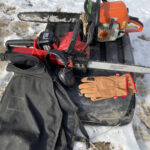
-
Gas and battery saws with protective equipment.
-
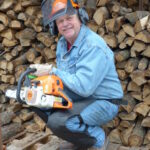
-
Rich in protective equipment.
-
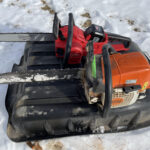
-
Quality gas and electric saws.
Final Thoughts
Rich has years of experience using many power tools and shares these thoughts:
Quality pays. “I buy quality tools, even if I have to wait until I save up enough money. Most of my tools are Milwaukee brand. The same batteries that power my chainsaw also power my drills, fans, vacuum cleaner, lights, inflater, hedge trimmer and other saw types. Many quality brands are on the market. They have their own specific type of battery that won’t work with other brands. So, I consistently buy the same brand for convenience.
Yard Tool’s Future
At Winding Pathways, we have replaced our gas lawn mower, snowblower, and now chainsaw with battery-powered equivalents. They are excellent and come with benefits over gas models. We see gas yard tools moving toward obsolescence and battery-powered ones becoming ever more versatile.
Disclosure*
Rich has purchased, at retail cost, most of his power tools. Milwaukee has provided others for testing.
by Winding Pathways | Mar 16, 2023 | (Sub)Urban Homesteading, Birds, Nature
Tree Sparrows. Two species. What could be more confusing? Well, there’s more. Both look like common House Sparrows (formerly known as English Sparrows.
Meet the American Tree Sparrows
Marion glanced at our feeders recently and noticed what looked like a Chipping Sparrow in the midst of a flock of House Sparrows. But it wasn’t. It was an AMERICAN TREE SPARROW. This bird nests in far northern Canada and is almost always spotted in winter. Why it doesn’t keep flying south and winter somewhere warmer than Iowa is a mystery to us. The bird does look like a Chipping Sparrow, but it’s bigger and “chippers” left long ago to winter where it’s warmer. We won’t see one again for a few months. So, a rusty capped sparrow in winter stands a good chance of being an AMERICAN TREE SPARROW.
Meet the New Tree Sparrows
Rich looked out the window a few days later and spotted an odd bird. It was near House Sparrows but looked slightly different. A dark spot on its cheek revealed it as a EURASIAN TREE SPARROW. What was it doing in our Iowa yard?
Back in 1870 a box of wild birds arrived in St. Louis from Germany. Inside were 12 Eurasian Tree Sparrows that were released. They slowly spread outward.
According to the Cornell University Laboratory of Ornithology’s ebird the bird spread north slowly and took about 150 years to reach our yard. It’s been widely spotted across the United States, but mostly along the Mississippi River.
Differences in Habitat Preferences
It looks like a House Sparrow at a quick glance. House Sparrows are at home in urban areas while the European Tree Swallow is more a denizen of brushy areas outside town. Sometimes they mingle. See a flock of House Sparrows. Take a close look. One may be a European Tree Sparrow.
European and American species share one trait. Both prefer feeding on the ground. Why they’re called tree sparrows beats us.
Learn More!
For accurate information on birds check out the Lab of Ornithology’s website.
-
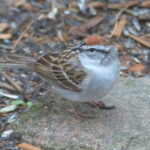
-
Chipping Sparrow
-
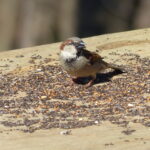
-
House Sparrow
-
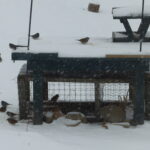
-
Can you find the sparrows?
by Winding Pathways | Mar 9, 2023 | Foraging, Geology/Weather, Maple Syruping
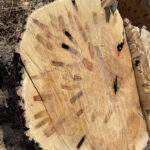
A slice of history.
Scars in a tree at the Indian Creek Nature Center reveal maple syruping history.
Back in 1979 Rich Patterson and volunteers approached a husky Box Elder tree, armed with a drill, spile, and buckets. It was early March. Nights were cold and frosty, followed by warm sunny days. Syrupin’ weather.
Oozing Out the Sap
As soon as the drill’s bit cut through the tree’s bark, clear watery sap oozed out.
Rich gently tapped in a metal spile and hung a bucket under it. By day’s end, two gallons of clear sap nearly filled the pail ready to be boiled into syrup.
-
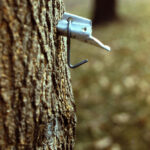
-
The spile angles slightly downward.
-

-
Visitors and plastic bag on tree
If not overdone tapping just harvests a small percentage of a tree’s sap. It’s sort of like a person giving blood. Taking a little does no harm. Healthy trees quickly create a scab over the tap hole, somewhat like a human body heals a scratch. As the tree grows and its trunk diameter swells, wood forms over the old tap hole. It’s fine to tap that tree again next year, the year after, and every following year.
Syruping season ends when night temperatures don’t drop below freezing. That’s when spiles are pulled, leaving the hole for the tree to heal.
Aging Out of Production
That’s what happened to the Nature Center’s tree. Box Elders are true maples capable of producing sap for quality syrup, but they are short-lived. An 80-year-old Box Elder is, well, elder and near life’s end. After being tapped for 40 years in a row the Nature Center’s box elder reached the end of its days converting solar energy into sugar. After its death staff felled it, revealing at least 30 tap scars. The oldest ones are closest to the center of the tree’s trunk.
Syruping is a fun late winter activity. To learn more visit the Indian Creek Nature Center during syruping season. It holds a fun Maple Syrup Festival in late March each year. For details check out Indian Creek Nature Center’s website.
Thanks, box elder for sharing some of your sap all these years.
-
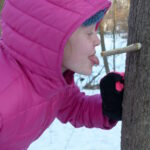
-
Tasting sap from a sumac spile
-
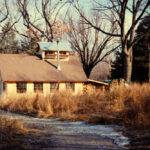
-
Syrupin’ time is upon us!
by Winding Pathways | Feb 9, 2023 | (Sub)Urban Homesteading, Garden/Yard, Nature, Wonderment
“Yes,” to Geese If You Please
Guest blog by Jody Vrieze
When we lived in Plymouth, Iowa, my husband and I realized there is more to a home than just a house. We embraced our love of nature and animals by creating a retreat in our yard featuring natural diversity and beauty. Our outdoor spaces incorporated annual and perennial flowers, bird feeders, chickens, and Sebastopol geese.
Stay-cations vs. Vacations
A backyard pond featured aquatic plants, and different fish like koi, shubunkin, and goldfish. Raised bed gardens and beekeeping gave us additional duties and joy to enhance our little piece of heaven. Every season brought new activities and treasures. We found that we much prefer quiet stay-cations over vacations!
Perhaps the Sebastopol geese were among my favorites. I would call them by simply saying, “Hi peep peeps!”. They’d be running and following me everywhere. Even as I kayaked! Amazing creatures.❤️
Finding Our Inner Geese Love
Their names are Winston, Willow, and Aspen. When you watch the videos, Winston is always in the lead and Aspen is the smooth-feathered goose. At a poultry swap, we dickered with a man over a pair of Sebastopol geese. We walked away and returned. By then the goose had laid an egg. My husband asked if we could buy that egg and the seller replied, “No, but you can have it.”. The man asked if we wanted the pair of geese we’d dickered about to which my husband replied, “Nope, we have an egg!” We bought pizza, and while eating I cradled the egg to keep it warm. We went right out and bought an incubator. After many adventures of incubator lessons – the right temperature, unplugged or not, and against all odds – on Mother’s Day Lucy hatched.
Winston, Lucy, and Aspen
Winston was added to keep Lucy company. After losing Lucy, a lady brought an egg from a gal in Nebraska to add to the “family”. Even more adventures awaited us with geese. One goose broke her leg and I used our koi pond for rehabilitation.
Winston, the goose, tragically lost several mates and lived to be five or so years old before meeting his demise.
Moving On and Planning Ahead
We have since moved and I’m looking forward to a new coop and some new chickens.
After I was asked to share our adventures for the Winding Pathways blogs, I found that I loved going back through the photos and videos and watching the fun we had.
Now in our new location, we recently had a pair of swans and their cygnet land in our field. They came one morning but are gone now. They must have been planning to hunker down for an impending January snowstorm.
-

-
What fun to interact with the geese!
-

-
Jody rehabilitated an injured goose in her koi pond.
-

-
The geese flock around Jody in the stream.





















